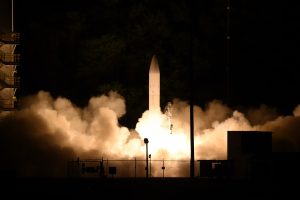On Tuesday the Russian Navy successfully tested its Zircon hypersonic cruise missile against a maritime target in the Barents Sea.
Russia’s state-owned TASS news agency reported that the missile was launched by the North Sea Fleet frigate Admiral Gorshkov, striking a maritime target 450 kilometers away and reaching a maximum speed of Mach 8. The Zircon was first tested from the Admiral Gorshkov against a land target in January and again in July.
The Zircon is a scramjet-propelled anti-ship cruise missile that has been under development since 2011. Russian President Vladimir Putin revealed in 2019 that the missiles will have a maximum range of 1,000 kilometers and that, following the dissolution of the Intermediate Nuclear Forces treaty with the United States in 2019, a mobile, land-based variant of the Zircon would be developed as well.
It was not reported whether Tuesday’s target was stationary or maneuvering when it was hit, leaving open questions about the effectiveness of the missile’s guidance and maneuverability. If the Zircon works as advertised, it would present a significant potential threat against any other navy’s surface fleet. The speed of maneuverable hypersonic weapons is so great that they are considered to be effectively impossible for targeted vessels to defend against.
TASS earlier announced that the Zircon would also be test fired from a submarine in 2020 alongside the surface tests conducted by the Admiral Gorshkov, but those launches have not been reported to have taken place yet.
The Zircon is launched from universal vertical launch tubes similar to the Vertical Launch System on U.S. Navy destroyers and cruisers. The Russian Navy’s Steregushchiy-class corvettes and Admiral Gorshkov-class frigates are equipped with this launching system. Russia has about six of these corvettes in service with 24 planned, and five frigates in active service out of a planned class of 15 vessels.
The U.S. Navy is also developing hypersonic missiles but is focusing on larger boost-glide systems that will be capable of much greater ranges and are more likely to be used for strikes against high-priority targets on land instead of against an adversary fleet.
The United States is attempting to develop defensive systems to shoot down an incoming hypersonic weapon, focusing on capabilities that can be fielded in the near term. Most of these efforts are being focused on the “glide phase” that longer-ranged boost-glide hypersonic systems utilize. These weapons are initially lofted to high altitudes using rockets or ballistic missiles before the weapon detaches and glides unpowered to its target at hypersonic speeds. Shorter-ranged scramjet weapons like the Zircon do not have this relatively lengthy glide phase and are powered for their entire flight.
Systems designed to intercept hypersonic weapons during an unpowered glide may not work against a scramjet-powered weapon. Instead, the U.S. Navy may have to rely on so-called “terminal phase” systems that try to hit incoming missiles just before they strike their targets, which may have much lower likelihood of success against hypersonic weapons. If the U.S. Navy cannot figure out a way to defend against anti-ship hypersonic weapons, they may have to find ways to sink the ships that carry them before they can be launched.

































